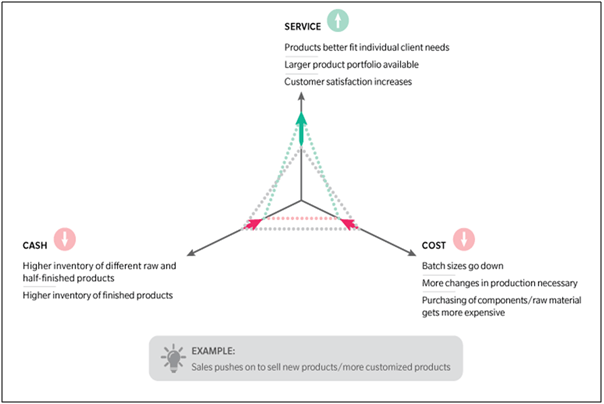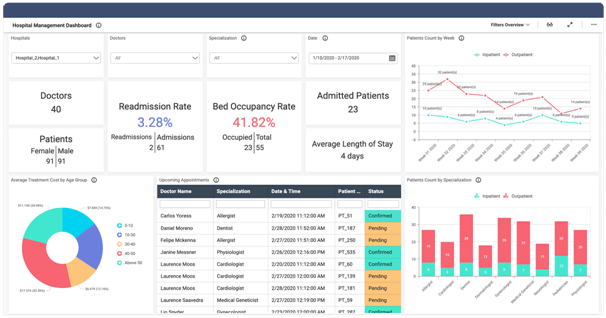The future of big data is unshakable and clear. Technologies like Internet-of-Things, machine learning, artificial intelligence, and more are making their ways into our daily lives. Data analytics is the process of analysing structured and unstructured data sets to provide real-time information that can facilitate the healthcare decision making and to maximize the decision value in the supply chain effectiveness.
Table of Contents
Big Data Analytics
Data analytics for optimizing and increasing efficiency and productivity which eliminate manual processes. The supply chain leaders can focus and create more values on other business growth and profitability. Analytics solutions offer an easy way to leverage business data. The expert should possess a good understanding of the different types of analytics, that is descriptive, diagnostic, predictive, and prescriptive analytics.

Descriptive Analytics
Descriptive analytics is a historical data statistically and to tell you what happened in the past. Descriptive analytics helps a business to understand how to interpret the available data information. This can be in the form of data visualizations such as graphs, charts, reports, and dashboards.
In a healthcare setting for instance, descriptive analytics able to tell the unusual high number of admissions to the emergency unit quickly. It provides immediate data with all the corresponding statistics (date of event, volume, patient demographics). Descriptive analytics provide a historic review of the operations, inventory, sales, financials, customers, and stakeholders.
Diagnostic Analytics
Diagnostic analytics takes descriptive data a step further, and provides deeper analysis to answer the question such as Why did this happen? It is characterized by techniques such as data discovery, data mining, drill down and correlations to dive deeper at the data to understand the root causes of events and behaviours. For instance, it may help to determine all the patients’ symptoms such as high fever, dry cough, and fatigue, point out same infectious agent.
Predictive Analytics
Predictive analytics takes historic data and feeds it into a machine learning model which considers the key pattern. The model will then be applied to current data to predict what will happen next.Predictive analytics estimate the likelihood of a future outcome based on patterns in the historical data instead of simply presenting information about past events to a user. This allows clinicians, financial experts, and administrative staff in a hospital to receive alerts about potential events before they happen. Hence, make more informed choices about how to proceed with a decision for a better patient care.
Prescriptive Analytics
Prescriptive analytics takes predictive data to the next step. When the experts have an idea of what will likely happen in the future, the next finding would be what should be doing next. It suggests various courses of action, outlines what the potential implications would be for every cases.It uses optimization and simulation algorithms to advise what action to take to eliminate a future problem. For example, an optimization in production scheduling and inventory in the supply chain to make sure the hospital can deliver the right products at the right time and optimizing the patient care. When illness is spreading, the prescriptive analytics tool may suggest increasing the number of staff on hand to adequately treat the influx of patients.
Establishing Analytics for Healthcare Supply Chain
Supply chain management is all about striking a balance between providing a service, managing cost within a set of Cash/Capital budget, also known as Supply Chain Triangle. The healthcare supply chain experts apply predictive analytics in the development of a Material Requirements Plan (MRP) using the exiting data from the hospital as well as to create a Supply Chain Analytics dashboard.
The diagram below shows the Supply Chain Triangle depicting the inter-dependency between Service, Cost, and Cash.

When creating the Supply Chain dashboard, it is important to know that in the hospital, a balanced strategy for the Supply Chain Triangle is critical. It is important to focus on product leadership (hospital services), customer intimacy (patient care), operational excellence (cost savings). Big data and algorithm production use for predictive analytics and not just output graphs and statistics but something that is actionable.
Hospital Supply Chain KPI Dashboard
Business analytics can be used to improve almost any part of healthcare operations. The hospital Supply Chain KPI Dashboard includes Hospital Operations Dashboard, Equipment and Supplies Dashboard, Patient Demographics Dashboard and Revenue Cycle Dashboard. By analysing patterns in Emergency Room (ER) care, hospital can refine their staffing strategies, determine how many nurses might be needed during different shifts. Similarly, the same analytics can be used to determine when the number of treatment rooms to be clean and how many janitors are required for each shift. This is also applicable across all patient care for the staffing of resources.
The recent program “Talking Point” featured in Channel News Asia for Covid-19 in Tan Tock Seng Hospital (TTSH). Dr Jamie Mervyn Lim (Chief Operating Officer) explained how the hospital using big data analytics and hospital operations dashboard to monitor and equip the readiness to respond to the second wave of spread in Singapore. TTSH incorporated Systems Dynamics thinking and artificial intelligence, coupled with real time visual management dashboards to the Bed Management Unit. The hospital deployed 20 staffs to monitor closely the needs of emergency care, at risk patients can be identified for pre-emptive care, the likelihood of readmission and other trends in patient care. These are just some of the ways data analytics can be applied in the healthcare industry. Solution providers or the healthcare leaders must develop the strategies, useful tools, and the analytical techniques to help healthcare providers get the most from the business analytics.

Revolution in Healthcare with Big Data Analytics
The environment is moving fast for Asia’s Healthcare system and larger health sciences sector has been pushed to battle against COVID-19. The world is changing, and inventive leaders are evolving new strategies. What are the trends which will impact future manufacturing, production, and biopharma supply chains up to clinical patient care with big data analytics?
To advance from big data analytics, it is vital to understand the driving forces and the developments that will not only improve the quality of care but also streamline efficiency within the hospital environment. These developments will strongly influence the way we think and design effective processes in the hospital.
The Big Data Analytics in Telemedicine
By developing a stronger relationship between patients and providers with Predictive analytics, it is enabling the healthcare providers to improve long-term engagement with patients. Data analytics can help providers react as quickly as possible to changes before symptoms clearly surface to the naked eye. Telemedicine is not a new concept but has not widely accepted in Singapore prior to Covid-19 pandemic. However, in response to Covid-19 situation and with advancements in technology, telemedicine market is booming and big data analytics is transforming telemedicine in a bigger way in connecting the patients with their doctors to maintain a higher level of patient safety and diagnosis.
A blend of big data with telemedicine is doing miracles in the medical and healthcare world in various way. The huge amount of health data being generated from the medical Internet-of-Things devices has established the health informatics which promises faster knowledge, analysis, and information sharing. The doctors can diagnose the patient based on the collected health data via wearable devices and carry out the diagnosis and improve on the outcomes. Big data analytics can be used to establish the right dose of medicine as well as the right course of treatment for the remote patients.
The use of telemedicine to patients for personalised treatment solutions and to prevent read missions would help to free up the hospital capacity and increase capabilities in battling Covid-19. Big data analytics in healthcare can then be linked to a predictive analytics program to predict medical experiences and improve the overall quality of patient care.By cutting admissions to hospitals, telemedicine consequently reduces the cost of care, both for the patient and the medical practice itself. Patients avoid long waiting times and doctors can optimise time on face to face appointments. Doctors can monitor patient condition from anywhere and at any time.
Health Data Privacy and Security
The healthcare industry is highly regulated, especially when it comes to providers ensuring the confidentiality of sensitive health information under The Health Insurance Portability and Accountability Act (HIPAA). Predictive analytics and artificial intelligence are also expected to play an important role in cybersecurity.
There have been various examples of ransomware infecting the healthcare systems, locking down the data. Public health systems will also need to safeguard confidential research data and supply chain information.
The healthcare industry must make strides in enabling more than providers to generate and use meaningful health data. This strategy could be exceptionally effective for preventing ransomware from affecting a healthcare organization. Early adoption of algorithmic protections such as machine learning or artificial intelligence resolutions will transform healthcare cyber defenses beyond the capabilities of average hackers.
Conclusion
Big data can allow healthcare businesses to work out problems that could not be tackled with traditional software or analytics previously. Big data can help in development by reducing the time needed to develop a product or process and get it to market. It can also keep the costs of operation down, improve patient results and promote innovation. In this contemporary world, every healthcare organization should be utilizing big data. Failing which there is a risk of operational inefficiencies. Overall, everyone in healthcare benefits from big data analytics.
References
Analytics Insight, (2020). “Big Data Technologies that are Expected to Flourish in 2020.” Retrieved from: https://www.analyticsinsight.net/big-data-technologies-expected-flourish-2020/ , accessed 09/09/2020.
Bold BI by Synfusion, (2020). “Hospital Management Dashboard.” Retrieved from: https://www.boldbi.com/solutions/healthcare/hospital-management-dashboard, accessed 09/09/2020.
Jasmine Tan, ADLSM. (2019). “Cold Chain Excellence Through Data Analytics”. Retrieved from SIPMM: https://publication.sipmm.edu.sg/cold-chain-excellence-through-data-analytics/, accessed 25/08/2020.
Lim Mun Heng, GDSCM. (2019). “Data Analytics for Optimizing Inventory”. Retrieved from SIPMM: https://publication.sipmm.edu.sg/data-analytics-optimising-inventory/, accessed 26/08/2020.
Oliver Wyman, (2020). “The Supply Chain Triangle.” Retrieved from: https://www.oliverwyman.com/our-expertise/insights/2018/oct/successfully-navigating-the-triangle-of-critical-supply-chain-interdependencies-in-production-companies.html, accessed 26/08/2020.
Priyankar Bhunia, (2018). “Saving lives with big data analytics that predict patient outcomes.” Retrieved from: https://opengovasia.com/saving-lives-with-big-data-analytics-that-predict-patient-outcomes/, accessed 25/08/2020.
Ruth Ng Yin Fun, ADPSM. (2019). “Data Analytics and Artificial Intelligence for Cognitive Procurement”. Retrieved from SIPMM: https://publication.sipmm.edu.sg/data-analytics-artificial-intelligence-cognitive-procurement/, accessed 25/08/2020.
Tan Shi Ying Jacelyn, ADPSM. (2019). “Technologies for an Effective Healthcare Supply Chain”. Retrieved from SIPMM: https://publication.sipmm.edu.sg/technologies-effective-healthcare-supply-chain/, accessed 09/09/2020.
Thomas Maydon, Principa, (2017). “The 4 Types of Data Analytics”. Retrieved from: https://www.kdnuggets.com/2017/07/4-types-data-analytics.html, accessed 10/09/2020.

